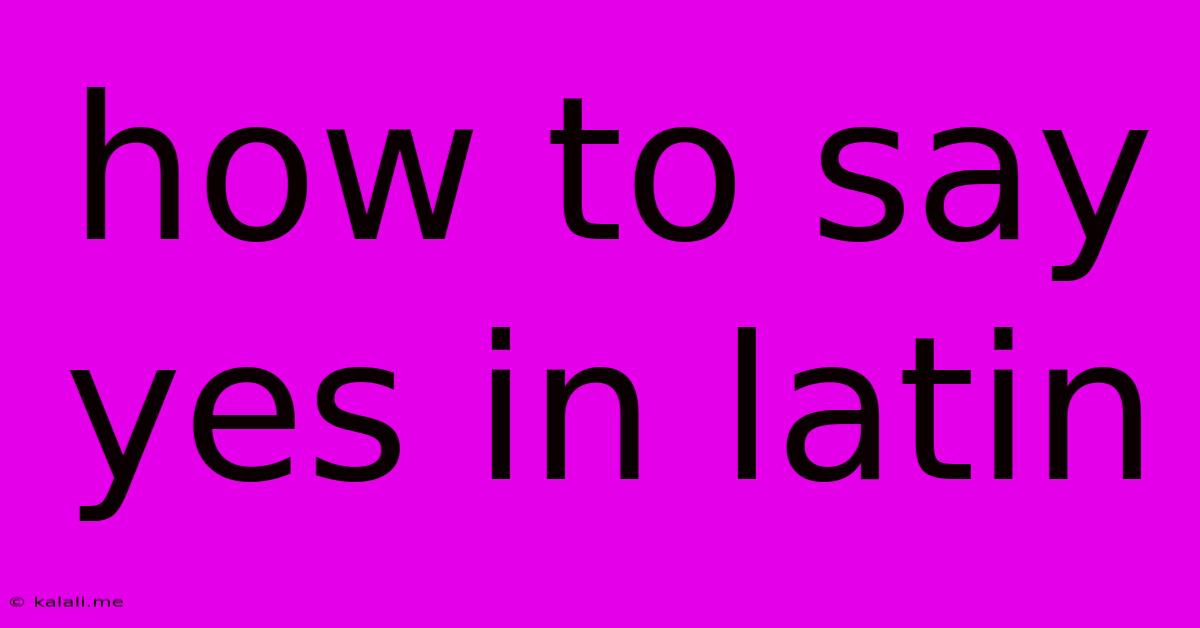How To Say Yes In Latin
Kalali
Jun 02, 2025 · 3 min read

Table of Contents
How to Say Yes in Latin: More Than Just "Ita"
Want to add a touch of classical elegance to your vocabulary? Learning how to say "yes" in Latin might seem simple, but it's richer than you might think. While "ita" is the most common translation, understanding the nuances of Latin agreement and context reveals a more sophisticated approach to expressing affirmation. This article explores various ways to say "yes" in Latin, considering the situation and the desired level of formality.
This guide will equip you with the knowledge to choose the perfect Latin affirmation for any situation, from casual conversations to formal declarations. We'll delve into the subtleties of meaning beyond a simple "yes," enriching your understanding of this ancient language.
The Most Common "Yes": Ita
The most straightforward and frequently used equivalent of "yes" in Latin is "ita." This word simply means "so," "thus," or "yes," and works well in most informal settings. Think of it as your everyday, go-to affirmation. However, ita is not universally appropriate; its usage depends heavily on context.
Alternatives to "Ita": Expressing Agreement with Nuance
Latin, being a highly inflected language, offers more nuanced ways to express agreement than a simple "yes." The choice of word depends greatly on what you're agreeing to. Consider these alternatives:
-
"Verum": This translates to "true" and is used to affirm the truth of a statement. Instead of a simple "yes," it conveys a stronger sense of agreement based on factual accuracy. For example, if someone says, "The sky is blue," responding with "Verum" emphasizes the statement's truth.
-
"Recte": Meaning "rightly" or "correctly," this word agrees with the correctness or propriety of an action or statement. Use it when confirming something is done properly or a statement is accurate.
-
"Bene": This translates to "well" or "good" and expresses approval or agreement with something positive. It’s suitable when responding positively to something favorable.
-
"Certe": This means "certainly" or "surely," indicating strong affirmation and conviction. It's a more emphatic way to say "yes."
-
"Etiam": Translating to "also" or "even," it expresses agreement and adds an element of emphasis, often implying that something is true in addition to other things.
Context is Key: Choosing the Right Word
The best way to say "yes" in Latin isn't about memorizing a single word, but understanding the context. Consider the following examples:
- Informal Agreement: "Estne dies solis?" (Is it Sunday?) "Ita." (Yes.)
- Affirming Truth: "Terra est rotunda." (The Earth is round.) "Verum." (True.)
- Approving an Action: "Bene fecisti." (You did well.) "Bene." (Good.)
- Strong Affirmation: "Veniesne ad cenam?" (Will you come to dinner?) "Certe!" (Certainly!)
Beyond Simple Affirmation: Expressing Enthusiasm
While the words above offer various ways to say "yes," you might need to express more enthusiasm or agreement. Latin offers expressive phrases beyond single words:
- "Ita vero!" (Yes indeed!) - Adds emphasis and conviction.
- "Sane!" (Indeed!) - A more forceful and emphatic affirmation.
Mastering the art of saying "yes" in Latin involves more than simply translating the word; it requires an understanding of the subtle nuances of the language. By considering context and choosing the most appropriate word or phrase, you can express your agreement with accuracy and style. So, go forth and practice! Your Latin conversations will be all the richer for it.
Latest Posts
Latest Posts
-
What Did Lorraine See In The Conjuring
Jun 04, 2025
-
Divine Soul Sorcerer 5e 1st Level Spells
Jun 04, 2025
-
Ms Word Small Caps Font Disabled
Jun 04, 2025
-
Can Airport Scanners Damage Digital Cameras
Jun 04, 2025
-
What Does It Mean When Cat Licks Your Hand
Jun 04, 2025
Related Post
Thank you for visiting our website which covers about How To Say Yes In Latin . We hope the information provided has been useful to you. Feel free to contact us if you have any questions or need further assistance. See you next time and don't miss to bookmark.